Angela Slatter's Blog, page 17
May 10, 2020
Into the Ashes: Lee Murray
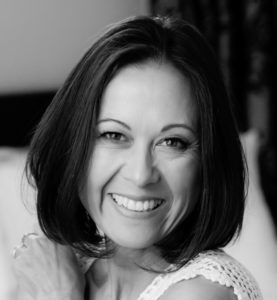 1. What do new readers need to know about Lee Murray?
1. What do new readers need to know about Lee Murray?
I’m a New Zealand writer and editor of speculative fiction for children and adults. I also write the occasional essay, review, and blogpost. Newsletters: almost never. If I write a shopping list, I’ll probably forget to bring it to the store. As an editor, I tend to do my best editing after I press send. Also, whereas the human body typically comprises 60% water, I am 60% cheese.
2. What was the inspiration for Into the Ashes?
Well, to start with, I needed to finish the series! Not only did I have a contract to fulfil, people, myself included, were hanging out to see what would happen between Taine and Jules, and whether Temera would regain his gift for seeing. However, the inspiration for this particular story came entirely from the New Zealand landscape. I was on a road trip with my son and husband, passing through the central plateau on a spectacularly clear day, and I remember thinking the region would make the perfect backdrop for the last book in the series. There were the mountains, the lakes, the army training grounds, and all the wonderful local legends and mythology associated with the area. Add to that, there’s the Taup? supervolcano, and our fear of ‘the big one’: a massive volcanic-earthquake event (New Zealand is sometimes referred to as ‘the shaky isles’ since we’re located on the Pacific Ring of Fire). So, in general, New Zealand’s geography is a wonderful source of story, and New Zealand storytellers have only begun to scratch the surface of what is possible. I think if we imbue our stories with our history and culture, throw in the call of the k?kako and the whims of our gods, then there is a point of difference, something unique that doesn’t appear in other literature. As a New Zealand writer, I feel there is a responsibility for us to tell our stories, to offer our perspectives in this moment, and our landscape is essential to that viewpoint. Then, on that same road trip, my son said, “Mum, you should call your book Into the Ashes.” And that’s how the book came about.
3. And as a broader question, what was the inspiration for the series (Into the Mist and Into the Sounds)? 
The idea for the first book, Into the Mist, came to me while I was out running in the New Zealand bush. Before sustaining an injury, I used to run marathons—completing 25 marathons and a couple of ultramarathons—which meant a lot of time running on trails. While the terrain can be dangerous, and the weather conditions can change rapidly, running in the New Zealand bush doesn’t offer up a lot of beasties. There are no mountain lions, no snakes and no grumpy bears. Probably, the worst thing a runner is likely to come across down here is a w?t? or two, or maybe a swarm of wasps. Out on the road, you might meet a stray pig dog, or a herd of cows on the way to milking, but I’ve never encountered anything on a bush trail. I was discussing this with some girlfriends while out on a trail for a long run once, and it occurred to me ‘what if there was something?’ and ‘what might that be?’ and the idea evolved from there. I went home and immediately opened a file which I optimistically called “Global Blockbuster” and that was how the series came about.
4. What draws you to the darker side of fiction?
I’ve always enjoyed reading dark fiction, but it was a real-life horror that called me to write it. My third book is a not-very-well-known YA novel called Misplaced, which is based on the disappearance of my dear friend, Florence, an artist and mother of three who went missing in France seventeen years ago and who has never been found. I wanted to address how a family might cope with that terrifying, paralysing reality. It is perhaps my most horrific work to date, and yet the only blood in it is a grazed knee. This is because horror operates on our basest fears, not just our universal instinct to avoid disembowelling by rampaging prehistoric monsters, but also those everyday anxieties, the little things that make us uncomfortable, the things that leave us with a “lingering disquiet”, to borrow Ramsey Campbell’s words. With Misplaced, I’d hoped to push back my runaway fears about what might have happened to my lovely friend; I’d hoped for a closure of sorts. As YA writer Alexander Gordon Smith says, “Something weird happens when you write about your worst fears, even if you’re writing fiction. They stop being these unfathomably, impossibly huge things that hide in the shadowy corners of your mind. They become words, they become concrete—or, at least, paper. They lose some of their power, because when they’re laid down like that then you have the control.”
5. You’ve been co-writing with Dan Rabarts for a while now – how did you guys find each other?
Oh, I’d noted Dan lurking in shadowy dark fiction corners of the interweb for a while, and when he put a call out for a writing exercise group, I joined up. The exercise in question involved writing a flash fiction piece based on a reddit thread about the creepy things kids say. Around thirty writers undertook to complete the task, some emerging and some established, who then swapped the stories between them for critique. And then someone said, “Hey, we should publish these.” Someone else suggested a children’s charity. And since I had some experience editing, Dan and I joined forces to co-edit Baby Teeth: Bite-Sized Tales of Terror. The book won us the Sir Julius Vogel Award for Best Collected Work and the Australian Shadows Award for Best Edited Work, as well as a whole heap of wonderful writer colleagues who make up the backbone of our New Zealand speculative community. By then, Dan and I had established a great working relationship, so when readers and friends started clamouring for another anthology, maybe with a mix of Aussie and Kiwi authors, we jumped in again to curate and co-edit At the Edge, which of course, includes a lovely foreword by you. Since then Dan and I have co-authored, co-presented, co-judged, and co-convened various literary projects. We also share joint custody of a couple of writing awards.
6. What’s your process for co-writing?
It varies depending on my co-writer. Most of my collaborative experience has been writing the Path of Ra, a Kiwi supernatural crime-noir series, with my Wellington co-author Dan Rabarts. Here’s a little excerpt from Teeth of the Wolf, the second book in the series, which features brother and sister protagonists, Matiu and Penny Yee. This excerpt sums up our collaborative process:
“What happened to my kitchen?”
“I had another toastie.”
“So I see.”
“Don’t start, Pen. It’s only a bit messy.”
“Well, clean it up, then.”
“Can’t. It’s a Friday. You know very well it’s not my dishes night.”
Penny rolls her eyes. “Don’t give me that. That roster was defunct years ago.”
“Can you do it? Please?” He pulls the puppy-dog face he used to make when he was trying to get out of the dishes back when they were kids.
Penny snorts. “Why should I?”
“Because I’m trying to work out where Touching the Sun have hidden Charlotte,” he says, immediately making her feel like shit.
Our writing collaboration is exactly like this bickering-yet-affectionate banter that goes on between the sibling characters in our books. When we embarked on our first collaborative novella-that-got-out-of-hand, we decided to use elements from our own lives to inform the narrative. I called on my science background and Chinese heritage to create stickler-for-rules science-consult Penny Yee; and Dan delved into his M?ori background, his job in security and his drama degree to conjure Penny’s adopted brother, Matiu, a matakite (seer) who walks with one foot in the shadowy underworld. We also made use of the quasi-brother-sister relationship that we’d previously established as editor-curators on the anthology projects I mentioned. I have two little brothers, so one more wasn’t a problem, and Dan has two older sisters. The result is a he-said she-said narrative where the two protagonists have to put aside their opposing ideologies and combined family baggage to solve a dark mystery. Just as Penny and Matiu discuss potential leads, sift through them, and follow the most promising among them, Dan and I sift and discard story threads, elaborating on those which best serve the story. However, Matiu and Dan have a dire tendency to lead the narrative down dark alleys, on desperate car chases, or into unexpectedly explosive situations, and it will be up to Penny and Lee to write those pesky little brothers back into line. The final book in the series Blood of the Sun will be released later this year.
 7. You were recently awarded the Mentor of the Year Award by the Horror Writers’ Association. How do you approach the mentor-mentee relationship?
7. You were recently awarded the Mentor of the Year Award by the Horror Writers’ Association. How do you approach the mentor-mentee relationship?
Thank you. It’s a huge honour to be recognised by the HWA for my work with emerging authors. In terms of an approach, since everyone’s process and pace are different, I usually let my mentees guide how we proceed. A lot of the success of any mentor-mentee relationship depends on developing an initial rapport, and in this regard the mentorship convenor has a lot of influence, pairing up people and projects on a best-fit basis. And that means understanding the relative skills and preferences of mentors and matching those to the mentees and their specific projects. It’s a tricky task. Once a mentee has been allocated to me, there’s the usual email introductions and exchange of contact details. Then I’ll start by reading an excerpt of the material, the synopsis, and any concerns / niggles the writer might have about the work in question—usually the reason the writer has requested the mentorship in the first place. I like to write a report (around 8-10 pages) based on that cold-read, and I might also mark up the manuscript with comments and suggestions, so the writer has something to refer to as they revise their work. After that, I’ll schedule an online meeting or phone call with the writer and we’ll get to know each other, discuss the work in hand, and determine a plan to progress the work which fits in with the writer’s own process. In general, I find mentees are willing to work especially hard to make the most of the opportunity; it’s an absolute pleasure and a privilege to be party to the author’s excitement when they see their work progress.
8. Who’s your favourite villain in fiction?
Hmm. Nurse Ratchet. Lady Macbeth. Austen’s Emma. Mr Rochester. Prince Charming. (Not from fiction but does anyone remember that Witchy-Poo from HR Puff ‘n’ Stuff used to scare me to nightmares as a kid.)
9. Who are your main literary influences?
Growing up, I believe mine was a very traditional GenX reading list for lovers of speculative fiction: Barrie, Tolkien, Lewis, Butler, Wyndham, Le Guin, Camus. I also loved Harper Lee, Rene Barjavel, Bernard Werber. However, as a writer, I’m not trying to copy anyone’s style, but rather to write the stories that resonate for me, hopefully with believable characters using authentic voices. On the other hand, there are definitely some writers I do try to emulate for their kindness and generosity and for their service to the writing community: people like Linda Addison, Jonathan Maberry, Rena Mason, Kaaron Warren…
10. What’s next for Lee Murray?
Thank you for asking! As well as the latest book in the Path of Ra series, Blood of the Sun, which I mentioned earlier and which will be released by our US publisher Raw Dog Screaming Press later this year, I also have a number of other publications slated for release in the coming months. The first of these is Grotesque: Monster Stories, my debut collection, coming in July 2020. I’m not particularly well known as a short story writer, so I’m hugely excited about sharing this book with everyone. Here is the blurb:
Three-time Bram Stoker Award® nominee Lee Murray delivers her debut collection, and it is monstrous. Inspired by the mythology of Europe, China, and her beloved Aotearoa-New Zealand, Murray twists and subverts ancient themes, stitching new creatures from blood and bone, hiding them in soft forest mists and dark subterranean prisons. In this volume, construction workers uncover a hidden tunnel, soldiers wander, lost after a skirmish, and a dead girl yearns for company. Featuring eleven uncanny tales of automatons, zombies, golems, and dragons, and including the Taine McKenna adventure Into the Clouded Sky, Grotesque: Monster Stories breathes new life into the monster genre.
I’m also curating an anthology of scary flash fiction and poetry by New Zealand secondary school students, coming in June. Called Scary Tales, the anthology is an annual project run by Young New Zealand Writers aimed at developing a love of speculative fiction and writing among New Zealand youth. What is especially scary is just how much talent is coming through the ranks—I’m going to have to get my game on. And finally, I’m thrilled to be co-editing an anthology of dark fiction tales by Asian women writing in English along with Australian editor Geneve Flynn. Black Cranes will be published by Omnium Gatherum in late 2020. Contributors include Nadia Bulkin, Grace Chan, Rin Chupeco, Gabriela Lee, Rena Mason, Angela Yuriko Smith, Christina Sng; and Alma Katsu, author of The Deep, will write the foreword. I feel strongly that this book is long overdue and especially important in the current climate. The cover blurb reads:
Almond-eyed celestial, the filial daughter, the perfect wife. Quiet, submissive, demure. In Black Cranes, Asian women of horror both embrace and reject these traditional roles in a unique collection of dim sum stories which dissect their experiences of ‘otherness’, be it in the colour of their skin, the angle of their cheekbones, the things they dare to write, or the places they have made for themselves in the world. Black Cranes is a dark and intimate exploration of what it is to be a perpetual outsider.
Bio:
Lee Murray is a multi-award-winning writer and editor of science fiction, fantasy, and horror (Sir Julius Vogel, Australian Shadows) and a three-time Bram Stoker Award® nominee. Her works include the Taine McKenna military thrillers, and supernatural crime-noir series The Path of Ra, co-written with Dan Rabarts, as well as several books for children. She is proud to have edited thirteen speculative works, including award-winning titles Baby Teeth: Bite Sized Tales of Terror and At the Edge (with Dan Rabarts), Te K?rero Ahi K? (with Grace Bridges and Aaron Compton) and Hellhole: An Anthology of Subterranean Terror. She is the co-founder of Young New Zealand Writers, an organisation providing development and publishing opportunities for New Zealand school students, co-founder of the Wright-Murray Residency for Speculative Fiction Writers, and HWA Mentor of the Year for 2019. In February 2020, Lee was made an Honorary Literary Fellow in the New Zealand Society of Authors Waitangi Day Honours. Lee lives over the hill from Hobbiton in New Zealand’s sunny Bay of Plenty where she dreams up stories from her office overlooking a cow paddock. Read more at www.leemurray.info. She tweets @leemurraywriter
Links:
https://www.facebook.com/lee.murray.393
May 7, 2020
The Bone Lantern
 So a couple of years ago, artist Lorena Carrington and I met at the Bendigo Writers’ Festival. We got on well, I sent her some books and she sent me some glorious art. One of those pieces of art was called “The Bone Lantern” … and I’ve carried that title around in my head ever since, thinking it must be a story in my Sourdough world.
So a couple of years ago, artist Lorena Carrington and I met at the Bendigo Writers’ Festival. We got on well, I sent her some books and she sent me some glorious art. One of those pieces of art was called “The Bone Lantern” … and I’ve carried that title around in my head ever since, thinking it must be a story in my Sourdough world.
I finished writing The Tallow-Wife and Other Tales a couple of weeks ago. I had been planning to put “The Bone Lantern” in there, but it wasn’t interested. It wants to be a tale all on its own. So, I said “Fine. You’ll be a novella. Wait your turn.”

Art by Kathleen Jennings
It will deal with Selke, who’s featured in other stories of mine. Artwork to the right by Kathleen Jennings – Selke’s wanted poster from the novella Of Sorrow and Such.
But then Juliet Marillier posted this wonderful article this morning by Sarbina Orah Mark “Fuck the Bread. The Bread Is Over” – go and read it, it’s magnificent.
And there’s a wonderful line in there about a fairytale girl being given ashes with which to make a rope … and that sparked a story to go within the larger story of “The Bone Lantern”. So, that’s below, and I’ve started scribbling notes …
“The Bone Lantern”
by Angela Slatter
Once upon a time, there was girl who was traded to a mage by her parents. They didn’t consider themselves bad parents – who ever does? – and they six other mouths to feed and the price of the oldest girl would keep the family afloat for a good year. After that, surely their fortunes would have turned around – and if not, there were always more children.
But back to the once-upon-a-time girl.
The mage, who was awful and knew himself to be so – they say monsters don’t know they’re monsters but that is, quite frankly, bullshit – put the girl in a room. The room was at the top of a tower and there was nothing in it except ash. Not really piles, because ash doesn’t lie that way, it’s too light and fragile, it builds in tentative layers, and flies at the slightest breeze. As there was an open window, there was plenty of opportunity for the ash to take wing and the air of the room was filled with grey-black shards of things-that-no-longer-were. The mage told the once-upon-a-time girl that if she could make a rope of the ash, then she could escape the tower.
And then he left, safe in the knowledge that she was a stupid village girl and she’d still be there in the morning.
But the girl was different.
She’d learned things from the old wood wife who lived out in the forest. Whenever the girl was sent to gather sticks and twigs for the fire, berries and mushrooms for the table, she would visit the tumbledown cottage and talk. She learned things that her mother did not know – but let’s be honest, the lessons our mothers teach us never really sink in until year later, when we’re older and find her pain growing in the very soil of our being – and so, she knew what to do.
She pulled three dark hairs from her head and curled them onto the windowsill. Then she gathered a small, shivering covey of ashes and balanced them on top of the hair. Next, she cut her palm with the little knife she always carried deep in the pockets of her skirt, and sprinkled the droplets over the top.
She whispered to it, secret words that made the ashes and hair and blood dance and twist and twine together. Soon enough she had a length of dark red rope. The once-upon-a-time girl tied it tightly to the hook in the wall by the window, hitched her skirts up between her legs and tucked them into her belt, then clambered over the sill.
But before she went, she cut off a piece and coaxed it into a noose, which she hung from the wooden beam above. She whispered to it a wish that the mage would find it irrestiable.
May 3, 2020
The Rampant: Julie C. Day
 1. What do new readers need to know about Julie C. Day?
1. What do new readers need to know about Julie C. Day?
*Need* to know? Probably not a whole hell of a lot. Meeting me in person doesn’t naturally translate into expectations met when you read my fiction! Actually, it definitely doesn’t. I tend to smile and have been told by those who only know me in my everyday life that I have a warm and sunny disposition. Ha! My fiction is surreal, dark, unexpected in how it unfolds, and often utilizes scientific facts as metaphor. Which is–in my estimation–the ingredients for a whole helluva lot of fun. I think what people mistake for a positive nature is actually an understanding that everyone has a tough time of it and that not ‘being in the shit’ makes it a good day. Note: You can’t see it through this computer screen, but I’m grinning right now. My sense of humor is…absurd.
On a more pragmatic note my first collection, Uncommon Miracles, came out 2 years ago. My first novella, The Rampant, came out last year and is currently a 2020 Lambda Literary award finalist. I’m always writing and always failing to finish and have at least two dozen projects slowly cooking on the hob. Right now–aside from Pandemic Living–a great name for a magazine, btw–I’m Editor-in-Chief of the charity anthology the Weird Dream Society. It comes out later this month with a slew of amazing short fiction writers all pitching in to create what I’m going to describe as a humdinger of a Table of Contents. You can pre-order it now. Yeah, I went there. All proceeds are going to RAICES, a nonprofit legal organization that’s working to help immigrants and asylum seekers at the U.S. southern border, a population of people who desperately need our help now, during this pandemic.
2. What was the inspiration for The Rampant?
The Rampant, like all my fiction, is a stew pot of ingredients. Emotionally, one of the biggest touchstones was my time as a child in Southern Indiana–the above-ground earthly location for the first act of the story. And then there’s the bits about caterpillars and how to raise them in underground skin fields along with bioluminescent microbes and mushrooms. I got to investigate and play with so many bits of the natural world when I created the various lands of the dead. And then there are my feelings about love and gender roles, along with my thoughts on religion and the self-awareness of nonhuman creatures.
It’s both a coming of age story and a quest story set in 3 different locations: Indiana, the underworld Plains (basically a brutal form of purgatory), and the Netherworld. As a short fiction writer, I wanted a story that guided me to stay within my lane. I have too many longer projects that I’ve been unable to corral. Basically, I am too easily distracted by new ideas that lead to one complication after another…
3. Who are your literary influences?
My influences are all over the map. We all read books for more than one reason. For me, comfort books are just as important as those that shake my brain. Jane Eyre was my 13-year-old obsession, though I hated Wuthering Heights. Brave New World was fascinating at twelve. Ray Bradbury lingered from ten through fifteen years of age. I read all of Isaac Asimov as a tween, including his incredibly self-indulgent multi-volume autobiography. I read the entire teen biography section of our library, as well as the Harlequin Romances my best friend and I found squirreled away in her basement, and then there was the erotica found tossed aside in the woods. Tanith Lee, mainly her science fiction and vampire fiction, caught my interest and Harlan Ellison’s short fiction hit me so hard, I’ve been afraid to return to it in case I ended up in a rage over unnoticed misogyny. Russell Hobern’s Riddley Walker, blew. my. mind. I’m not sure I loved it as much as couldn’t put it down. Unfettered writerly wildness-the use of language, the dialect. In my early twenties I discovered Ford Maddox Ford’s The Good Soldier and reveled in the structure of that novel and the way each of the four sections of the novel seemed to tell the whole story, and yet didn’t. I’ve reread it often. And then there was Jean Rhys’s Wide Sargasso Sea, a retelling of Jane Eyre from the ‘mad’ wife’s perspective. Mrs. Dalloway made me throw her across the room, but I found my way eventually and stretched a bit more. And, of course, the list goes on: Anaïs Nin, Douglas Adams, Kizuo Ishiguro, Anne McCaffrey, Harry Harrison, and so many others.
If you can’t already tell, I was not a discerning reader and I didn’t stick with any particular canon. But I read a lot starting at about the age of eight, and something about that magpie approach to fiction formed who I am today. It continues to do so. Because I continue to be influenced by every damn writer I read. That list of authors I admire and take into my heart is a living, breathing list. It is ever evolving.
4. When did you first realise you were going to be a writer? 
It’s more a matter of when I finally allowed myself to be a writer. When I was a kid I wanted to be an astronaut, a marine biologist, and a writer. Something about my creative endeavors seemed illegitimate. I was good at science. I loved academic classes. Being creative just didn’t fit with the person I was supposed to be. It didn’t help that my approach to writing is not a generally seen as standard. A moment or a feeling come first, worldbuilding follows, along with attempts to figure out the characters. Eventually, at the very end, plot arrives. It looks messy to anyone watching my progress from the outside. It was easy to judge myself as a daydreamer without any particular ability or ability to get better. I wrote for years without finishing anything except some poetry and a few short stories. And then around the age of 31 I decided I really could do more. I went to my first workshop, the Banff Writers’ Conference and I negotiated reducing my dayjob schedule to 4 days a week. Then came children–a long and difficult pause or perhaps a slide–and eventually an inability to not write anymore.
I still have trouble with the idea that I am a legitimate writer rather than a writer aspiring toward professional status. I honestly don’t know if that will ever not be with me.
5. What’s next for Julie C. Day?
Well, I have two starts to longer works that kept nudging me from the corner. One is Mesotherms a story about humans with gorgon attributes, climate chaos, desperation, snake-based class divides, and the ways in which humanity can change–beyond snakes. Another is a novella that is about 2/3 done. Every Thought a Sin which again addresses climate chaos, but this time with human modification via microbe infused murals. I have a few short stories waiting for my attention, as well. “No Whole Bodies Are Left Behind” is the one closest to completion. I’m hoping my Pandemic Induced Creative Lethargy shift soon. I keep trying, which is all any of us can do.
Oh, and I have a new story in the anthology The Way of the Laser: Future Crime Stories. The book is available for pre-order. While I often write science fictional stories, in my own strange Julie way (Every Thought a Sin is one such story), I’ve realized most of my publications are closer to fantasy. This one is not. And I sort of adore what I did with it. There is nothing I enjoy as a writer more than twisting those writerly rules and trying new things. It’s what my creative brain craves. I hope you get to read it, actually. I’d love to hear your thoughts
You can find out more about Julie C. Day here.
May 1, 2020
The Dark, May 2020
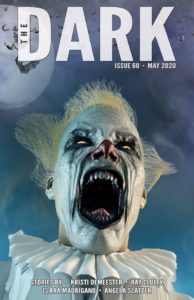 Or, as I like to think of it, The Creepy Clown issue!
Or, as I like to think of it, The Creepy Clown issue!
The May 2020 issue of The Dark is out! With stories by myself, Clara Madrigano, Kristi deMeester and Ray Cluley. 
“Sleeping in Metal and Bone” by Kristi DeMeester
“The Whalers Song” by Ray Cluley (reprint)
“Driving with Ghosts” by Clara Madrigano
“Honor Thy Mother” by Angela Slatter (reprint)
Locus Reviews: The Heart is A Mirror for Sinners and Other Stories
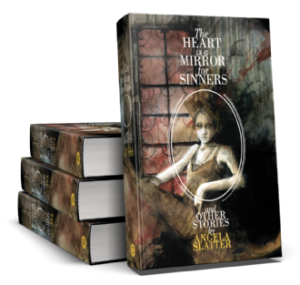 The wonderful Paula Guran has very kindly reviewed The Heart is A Mirror for Sinners and Other Stories for the May 2020 issue of Locus. This is my birthday month, so it’s wonderful to find words such as these in the Year of the Plague:
The wonderful Paula Guran has very kindly reviewed The Heart is A Mirror for Sinners and Other Stories for the May 2020 issue of Locus. This is my birthday month, so it’s wonderful to find words such as these in the Year of the Plague:
“British and World Fantasy Award recipient Angela Slatter’s writing is elegant, eloquent, evocative, and exquisitely disturbing; polished to the rich patina found only on the finest quality antique silver, it casts a spell on the reader. Luckily, the Australian author is nearly as prolific as she is talented. The Heart is A Mirror for Sinners and Other Stories is her eighth collection (two of the seven previous ones were co-written with Lisa L. Hannett). This latest compilation offers a wide range of stories: mythic/folkloric, gothic, dark humor, Lovecraftian (both serious and not), even forays into science fiction and hard-nosed detective fiction. The women in Slatter’s stories tend to be cut from the same fabric: they may make mistakes, but they gain the strength to claim life or gain revenge or do whatever must be done. They are shrewd, brave, and usually triumph – not that they are always on the side of good or light.”
There’s more, much more, but you’ll need to get Locus for that. A huge thanks to PS Publishing for producing such a gorgeous edition, with Daniele Serra‘s magnificent cover art.
April 25, 2020
The Tallow-Wife and Other Tales
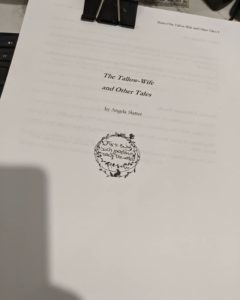 An extract from the Afterword:
An extract from the Afterword:This book has taken a long time to write.
I began it at the end of 2013, after The Bitterwood Bible and Other Recountings had been sent off to Tartarus Press. I was fortunate enough to be awarded a Writer’s Fellowship by the Queensland Literary Awards to help me develop it. I’ve been writing and re-writing it ever since – wonderfully patient folk at the Literary Awards, let me tell you. Almost as patient at Rosalie and Raymond at Tartarus, frankly.
The first three stories have been published. The Tallow-Wife”, “What
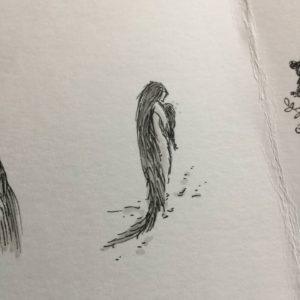
“Bearskin”, art by Kathleen Jennings
Shines Brightest Burns Most Fiercely” and “Bearskin” all in A Feast of Sorrows (Prime Books, thanks, Sean Wallace and Paula Guran). The titular novella was released as a limited edition by Fablecroft in 2017 for Conflux – we only did fifty of those, so if you’ve got one, congrats! It’s rare as hen’s teeth. I’d thought (way back in 2013), that this would be my last foray into the world of Sourdough and Bitterwood. Thought I’d exhausted the seam – as I said, this book took a long time to write. And now, I’m penning the “Afterword” in the Time of Plague, the Covid-19 pandemic; it feels very Decameron, although with fewer rats and buboes. It feels very strange.
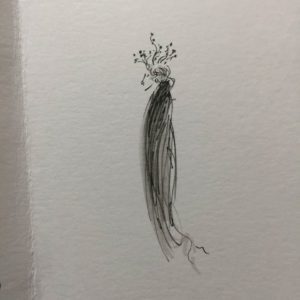 Don’t get me wrong: I was writing. I was writing a lot. Then I was rewriting, amending and deleting, hacking and slashing, polishing then setting everything on fire and tossing it in the bin. Casting spells, sacrificing chickens, making promises to dark gods. Sulking, then starting again.
Don’t get me wrong: I was writing. I was writing a lot. Then I was rewriting, amending and deleting, hacking and slashing, polishing then setting everything on fire and tossing it in the bin. Casting spells, sacrificing chickens, making promises to dark gods. Sulking, then starting again.
But at last it is done. I just need to give it a final edit and Kathleen Jennings is finishing up the artwork, then it will be off to those lovely folk at Tartarus.
The Table of Contents is:
Introduction by Helen Marshall
The Promise of Saints
The Tallow-Wife
What Shines Brightest Burns Most Fiercely
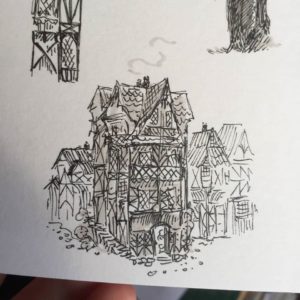
“Of Ghosts and Glory”, art by Kathleen Jennings
Embers and Ash
Bearskin
The Nightingale and the Rose
Of Ghosts and Glory
A Stitch in Time
Sleeping Like Snow
Crossroads
And A Young Husband to Bury Me
By Such Paths
Afterword
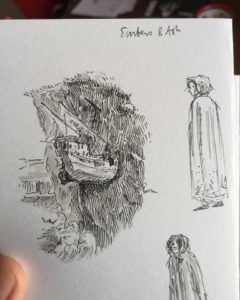
“Embers and Ash”, art by Kathleen Jennings

“Embers and Ash”, art by Kathleen Jennings
April 19, 2020
Into Bones Like Oil: Kaaron Warren
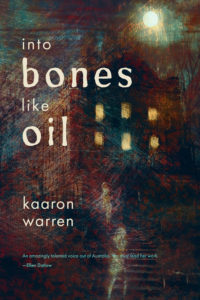 1. What do new readers need to know about Kaaron Warren?
1. What do new readers need to know about Kaaron Warren?
I’m afraid of the dark, large crowds, mold spores, confined spaces, violence, unpredictability, loss, viciousness, a lack of kindness. I’m afraid of the world my children will have to live with.
Some people say to write about the dark side of life you need to be immune to it.
I say the opposite. It’s only by being deeply affected by the world around me that I can write stories that have any value.
2. What was the inspiration for your novella Into Bones Like Oil?
This is one of those stories that cooked for a long time. It wasn’t until I finished writing it that I realised quite how long.
There are two major inspirations for the novella. One is Safe Houses programme, the other is a boarding house I stayed in very briefly 25 years ago.
I recently found a newspaper clipping I saved from 1995, talking about Safe Houses and some inadequate checks that went on. A Safe House carried a sign out the front, and children could run there, in theory, and find a safe place if they felt they were in danger.
The thing was, I had a boyfriend in the early 80s, who had fallen on hard times and was living in a caravan in his sister’s backyard. Her house had one of those Safe Houses signs. But she lived in an abusive relationship, and my boyfriend lived with his ‘uncle’, a very, very seedy man I didn’t trust for a second. Safe House, my arse.
Another boyfriend and I (not fallen on hard times, and now my husband) stayed in a Boarding House in Melbourne when we were there for a wedding 25 years ago. I was profoundly influenced by this place; by the people who lived there permanently, and those who were just staying over, by the couple who ran the place, by the smells, the sounds, the whole thing. I realised as I wrote “Into Bones Like Oil” that I had been collecting inhabitants for my own Boarding House ever since.
3. What draws you to horror?
So many things. I like the honesty of horror. I like the surprise endings, the unpredictable developments, the truth of it all. I’m often disappointed by a happy ending because they can have a sense of compromise about them, of giving in to ‘good feeling’ rather than staying true to the story. Horror rarely has a happy ending.
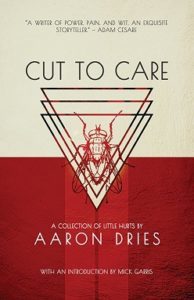 4. Which books are you looking forward to reading this year?
4. Which books are you looking forward to reading this year?
Cut to Care Aaron Dries’ first short story collection, from Poltergeist Press.
The Attic Tragedy, a novelette by J. Ashley Smith from Meerkat Press. I’ve had a sneak peek at this this and it is bloody good.
Cat Sparks has a collection coming out from Newcon Press. Called Dark Harvest, I can’t wait to get my hands on it.
Robert Wexler had a collection coming out, his first book for ages. That’s from PS Publishing.
5. What’s next for Kaaron Warren? 
I’ve signed with IFWG Publishing to bring out four books. The first will be a small chapbook, inspired by a collaboration between myself and Ellen Datlow on Facebook. Ellen’s amazing photos of her odd tool collection, my flash fiction in response. It’s going to be fabulous.
IFWG will also bring out a backlist of three of my novels. I recently got the rights back for Slights, Walking the Tree and Mistification. Walking the Tree will come out in illustrated form, with an additional novella written from the point of view of a child . Slights and Mistification will both have new bits as well.
I have two novellas coming out from Cemetery Dance. One is Bitter, a novella about a giant iron man and what comes out of his toe. The other is a reprint of The Grinding House.
There’s also this anthology, Gods and Globes 2. It looks so cool, and has a story of mine I had a ball writing, inspired by a trip in the bus from Chicago to Grand Rapids for Stokercon, and also my time in Rotorua during the NZ Natcon.
April 17, 2020
Out of Water: Sarah Read
 1. What do readers need to know about Sarah Read?
1. What do readers need to know about Sarah Read?
I love writing gothic and spooky fiction. I love reading all sorts of things from many different genres. I’m a history buff, a librarian, a knitter, a mom–I’m basically Mary Poppins, which is great so long as I continue to use my powers for good. I have two books out, my debut novel THE BONE WEAVER’S ORCHARD and my debut collection OUT OF WATER, both nominated for Bram Stoker Awards! I have a husband who is very tall, two adorable sons, and a marble tabby cat lioness. I attract spiders with my uncanny arachnid magnetism.
2. What was the inspiration for your collection Out of Water from Trepidatio?
There were lots of little ones, all running in different directions. There is definitely a water pattern in my writing. In all of the stories, there are either things born from water, crawling out of the water, they’ve run out of water, or they are fish out of water. So that’s why I chose the title. There are a lot of family themes. I like weaving science into my stories, because I’m a big nerd. Sometimes I read about some scientific oddity and have to write a story around it. Other stories were written to process grief. Some to face my own phobias–Endoskeletal was written about my fear of broken bones, mixed with my fascination for archaeology.
3. Who are your literary influences?
The Brontes are a strong influence for me, and Anne Rice. I read a lot of Dean Koontz as a kid, and though I don’t register the influence, there must be some. Caitlin Kiernan was a favorite in my teens. Angela Carter and Connie Willis. Once a friend introduced me to Gaiman’s Sandman comics when I was 15, that set a definite trajectory, I feel. That mingling of horror and fantasy and myth is exactly my preferred spice blend. Gothic classics like The Secret Garden and Grimm’s fairy tales, with an extra layer of shadow–something witchy with its bones on the outside. Brian Froud’s fairy books led me to deeper readings of older tales. A lot of the threads I followed started in anthologies compiled by Ellen Datlow and Terri Windling.
4. Can you remember the first thing you ever read that made you want to be a writer?
It was probably Anne of Green Gables! Or Little Women. Relating to those imaginative characters who became writers was formative for me. I know I was writing before I read those books, though–some evidence of this still exists in a box somewhere–and I’m not sure I ever thought I’d be anything else.
5. Who’s your favourite villain and why? 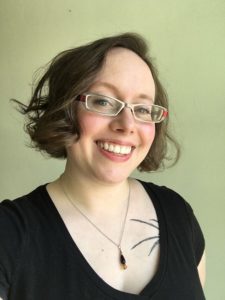
Ooh, I love this question, even though it is almost impossible to answer. My standard answer is Captain Hook, though not for any profound reason–I just like Peter Pan and I like pirates. Thoughtful answer would probably be The Nothing in The Neverending Story. The vanishing of imagination is a terrifying prospect.
6. What’s next for Sarah Read?
I’m editing a novel to start submitting to agents soon! I’m very excited about the project, even though I know this is now entering the excruciating phase of the process. I’m also working on a prequel and sequel for Bone Weaver, and having a ton of fun writing both. Of course, that means a bit of a drought when it comes to actual releases. Having all my work come out in 2019 means it may be a while before the coffers are refilled. I do post bits and pieces on my Patreon page, though, for my followers to read there. And of course there will be an occasional sprinkling of short fiction.
April 14, 2020
As Summer’s Mask Slips and Other Disruptions: Gordon B. White
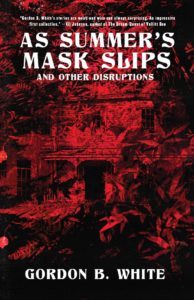 1. What do readers need to know about Gordon B. White?
1. What do readers need to know about Gordon B. White?
I’m not sure what readers need to know about me, but there are some things they might be interested to know.
I grew up in North Carolina. My dad’s side of the family has deep roots in the eastern part of the state, so I spent a lot of time in the rural areas when I was growing up. I didn’t realize at the time, but a lot of what I was absorbing then – the settings, the people, the stories and tall tales, the back country roads and that heavy air of religiosity and superstition – have resurfaced in my writing as I’ve gotten older. There’s some truth, it seems, to the idea that childhood fills the well we draw from as adults.
For college, though, I went as far from home as I could (as young people often tend to do) and ended up living in New York City for about a dozen years. Those, then, are my two poles – the rural and the hyper-urban; the small town and the big city; the familial history and the metropolitan anonymity. While sometimes one side or the other takes precedence in any particular story, that liminal, boundary space is where I think most of my writing falls.
I’ve always been writing, but I didn’t start to seriously pursue publication until around 2012, when I finished grad school. During my second year, my father passed away after an unexpected and devastatingly quick battle with cancer. Part of my reaction was to re-evaluate my priorities and one of my conclusions was that I needed to treat my passions as being as worthy of serious effort as my professional work. I stopped letting myself make excuses as to why I didn’t at least try to get things published, and so I asked myself, “What is it that I really want to write?” What immediately came to mind was my love of ghost stories and strange tales – most of which I’d learned from my father – and so that’s what I began focusing on.
Now for the lightning round: I have a terrible visual imagination, but am a stickler for excellent prose. I’m a graduate of the Clarion West Writing Workshop (Class of 2017 – Team Eclipse!!) and now board member. I do a lot of book reviews and author interviews for various outlets because I love analyzing things.
At present, I live in Seattle with my wife and our dog, Saucy. Saucy features prominently in most of my social media and promotional imagery. It’s gotten to the point where my editor, Scarlett Algee, has suggested I caption my author photo with the clarification: “Gordon B. White (right).”
2. What was the inspiration for As Summer’s Mask Slips and Other Disruptions from Trepidatio?
As Summer’s Mask Slips and Other Disruptions (Trepidatio Publishing) is my first collection. It collects fifteen stories – thirteen reprints and two all new ones – that were written between 2013 and 2019. One of them (“Mise en Abyme”) first appeared in the 2016-Stoker winning anthlogy Borderlands 6, while the closer (“Birds of Passage”) is going to be in this year’s The Best Horror of the Year Vol. 12.
This version of As Summer’s Mask Slips isn’t the first one, actually. I had originally submitted it around in a more bloated, less focused version – with more stories, but in a less coherent fashion. After it was politely declined from all publishers, though, I sat down and really looked hard at which stories I had available (including some new ones written during the book’s first doomed perambulation), and which ones really fit together. I trimmed out the wilder digressions, put in a few stronger pieces, and re-ordered the collection to create a more focused, curated experience. I tried to keep a thematic consistency – families, nature, dark intrusions into (near-)contemporary real world life – while presenting it in a way that highlighted my strongest and/or best-received pieces.
I aimed to create a flow to the way the reader experiences the stories from first to last. I’m a fan of structures and forms, whether overt or hidden, and so I grouped the collection in a way that it follows a thematic and emotional arc from beginning to end. There’s a modulation in the length of the pieces and the emotional content, so that every three or four stories complement each other, but also form a larger part of the overall flow. Just as a brief example, the general thematic tenor of the stories flows from “punishment,” to “resistance,” to “transcendence.” It starts pulpy and gets dark and ends sublime. (At least, I hope so!)
While there are quite a few B-sides and rarities that didn’t make the album (to adopt a lazy metaphor), I still love almost all of my stories. Some of them, though, just didn’t fit here. Some pieces – like the odd mash-up of J.G. Ballard’s The Atrocity Exhibition and Samuel Taylor Coleridge’s “The Rime of the Ancient Mariner” in my story “The Albatrossity Exhibition” – just work better as singles. (For now… who knows what complementary pieces may exist one day?)
All in all, this revision and reorganization it seems to have worked out for the better. I’m much happier with the leaner, more focused version of As Summer’s Mask Slips and Other Disruptions. Readers seem to appreciate the focus, too – it received a starred review at Publishers Weekly and reader reactions have been very kind. I’m particularly pleased that each reader seems to have a different favorite story.
3. Who are your literary influences? 
It’s always hard to name influences, I think. In part, there is an inclination to list those authors which one aspires to, even if their influence isn’t actually present. There’s also a difficulty in being blind to those influences that readers can see. There’s, also the fear of leaving someone out! With that caveat, here’s a staggeringly incomplete introspection.
I think my primary influence comes from my father’s tradition of ghost stories and tall tales. He was a born storyteller and so possessed of the gift of gab that you’d swear he kept a sliver of the Blarney Stone under his tongue. I grew up with so many wonderfully, casually strange and magical stories at bedtime, around the campfire, and just driving down the highway, that they couldn’t help but shape my own approach to narrative.
His real gift, though, was his ability to blend influences and make the weird seem as if it could happen just next door. It wasn’t until I was older that I realized how many of his “true ghost stories” were repurposed Algernon Blackwood or M.R. James tales which he’d replanted in eastern North Carolina. That sort of seamless mixing of elements while grounding them in the real world certainly influenced the stories I try to write.
For authors, though, I think, like many males of a certain age and disposition, Raymond Carver and Denis Johnson loom large in my canon. Raymond Chandler, Flannery O’Connor, Cormac McCarthy, Joyce Carol Oates, Lydia Davis, Thomas Ligotti, too.
As I list them, it occurs to me that I love about them all is the strength of their prose and the clarity of the voice in their work. To me, the quality of the writing – the sound of the words, the flow of them on the page, the personality that leeches out from the syntax and diction – is my primary pleasure in reading. I don’t have a great visual imagination – I usually find it hard to visualize images, when I do they’re usually washed out and static – so I don’t fall into a fictive dream unless the words themselves and the authorial voice grab me and give me that “buzz.”
For that reason, I also love poetry, even though I don’t write much of it anymore. In part, I think that’s because I don’t have a strong desire to explore the speculative through poetry, so as I’ve been more and more focused in writing horror and weird fiction, the times when I think poetry is the optimal form for my own expression has diminished.
Speaking of poetry, I am also a big fan of structures and forms in poetry and also in narrative fiction, as well. To that end, Kij Johnson has been a huge influence. Her concept of “hidden spines” in stories changed how I approached writing stories for the better. Adam Golaski is another author who had a similar influence – the way his stories are wonderfully written horrors but seem to be scaffolded on a structure that readers catch hints of but cannot fully discern from the outside makes them into utterly weird, beautiful gems.
There are ten thousand that I’m forgetting, so I don’t want to go any further for the moment.
4. Can you remember the first thing you ever read that made you want to be a writer?
Another tough one! The first dream I can recall ever having was of a book – it was a still image of the cover of a book called Odd One Out. However, it was a picture book, so that probably didn’t spark my desire to be a writer….
I’m not really sure, as I was a voracious reader as a child but I can’t really pinpoint what it was that made me want to write. I remember in third grade we had an assignment to write a story so that the teacher could laminate and bind them as part of a project …. and I wrote, like, five, but that was probably more out of boredom than wanting to be a writer. I was always imagining things, and I don’t know when I decided that writing it down would be the way to go.
I’d always been good at analyzing and essaying, but as for fiction…. I really don’t know.
Actually, I think probably it came in middle school when I was drawn to tie-in novels and source books for RPGs like Dungeons & Dragons (particularly the Forgotten Realms and Ravenloft novels) or Shadowrun, but I didn’t have enough nearby (or similarly inclined) friends at the time to play those with. At some point, I began to write out adventures where I was playing all the characters myself, and what is that but a narrative story? I think I also wrote extended Blade Runner universe fanfic around the same time, so that period was really where playing with others was replaced by writing for myself. From there, though, my other influences crept in and now here I am.
5. What’s next for Gordon B. White?
There’s a strange sense of both satiety and hunger that has accompanied publication of As Summer’s Mask Slips. Part of me thinks I should slow down and take my time on the next thing; part of me thinks I should speed up. All of me thinks there aren’t enough hours in the day. For now, I’m continuing to plug away at short stories for the time being. I also have a full slate of book reviews for Hellnotes and The Outer Dark’s podcast, as well as author interviews for Nightmare Magazine.
While Covid-19 has thrown some yet-to-be-announced projects into doubt, my story “Birds of Passage” will be part of The Best Horror of the Year Vol. 12 (edited by Ellen Datlow) later this year. Other plans and publications are less concrete at the moment.
Assuming that the pandemic subsides, I have a few live appearances scheduled for later in the year. I will (hopefully) being doing my first solo reading at my hometown bookstore, Quail Ridge Books, in Raleigh, NC, on June 21. I’m also slated to be a guest at The Outer Dark Symposium, which I will move heaven and earth to attend.
Finally, I have a long-standing and nebulous drive to one day write a Weird West legal thriller featuring a retired gunslinger turned lawyer. Maybe I’ll begin that soon…
Bio:
Gordon B. White has lived in North Carolina, New York, and the Pacific Northwest. He is the author of the collection As Summer’s Mask Slips and Other Disruptions (Trepidatio Publishing 2020). A graduate of the Clarion West Writing Workshop, Gordon’s stories have appeared in dozens of venues, including The Best Horror of the Year Vol. 12 and the Bram Stoker Award® winning anthology Borderlands 6. He also contributes reviews and interviews to outlets including Nightmare, Lightspeed, Hellnotes, and The Outer Dark podcast. You can find him online at www.gordonbwhite.com.
March 28, 2020
These Foolish & Harmful Delights: Cate Gardner
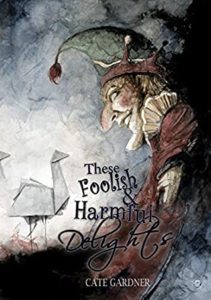 1. What do new readers need to know about Cate Gardner?
1. What do new readers need to know about Cate Gardner?
She’s currently wondering why she’s living on a movie set and everyone is running past with toilet paper. Enough of that third person bullshit. I’m loyal, fierce when it comes to protecting my friends, a weakling when it comes to protecting myself, and married to the awesome writer (and person) Simon Bestwick. I live on the Wirral peninsula, near the beach, have a nephew-dog, hail from Liverpool, and dream of living in Wales. I had my first story published in 1993 (when I was 4, obviously), and have had several dozen stories published over the years.
2. What was the inspiration for These Foolish & Harmful Delights?
Honestly? A huge gap since my first collection, Strange Men in Pinstripe Suits, was published. Also, I wanted to collect my published novellas together, especially as three of them are now out-of-print. Another motivation was I wanted my novella, Barbed Wire Hearts, to be published again. I’m not certain if I’m allowed to say this, but it’s the favourite thing of mine I’ve written.
3. What draws you to writing the weird?
I wish I knew. As a kid, I loved the Magic Faraway/Enchanted Forest books by Enid Blyton, and they seriously had some odd adventures. I guess my brain is just fried that way. I like odd things and odd people, maybe because I consider myself far too ordinary.
4. Which books are you looking forward to reading this year?
The entirety of my to-read-shelf (shelves). I’ve not read as much as I should over the past few years, so in January I decided to dig into and clear my to-read pile. Unfortunately, I keep adding to it. It’s not actually unfortunate at all. I have all kinds of wonders there from people such as yourself, Priya Sharma, Rob Shearman, Laura Mauro, Mr King, Thana Niveau, and so on. I need to pick up a copy of Georgina Bruce’s novella Honeybones from TTA Press. I read her collection last year and it was weirdly delightful.
5. What’s next for Cate Gardner? 
Oh man. I have one short story due to be published, and that’s not until Jan 2021. That is so pathetic. I’ve not been in the best of mental health for a few years. I’m now coming out the other side (or was until the world went insane) and settling down to write again.
Bio: Cate Gardner lives in the wilds of Wirral and is currently pining for the beach thanks to self-isolation. Her latest collection, These Foolish & Harmful delights is available from Fox Spirit Press.



